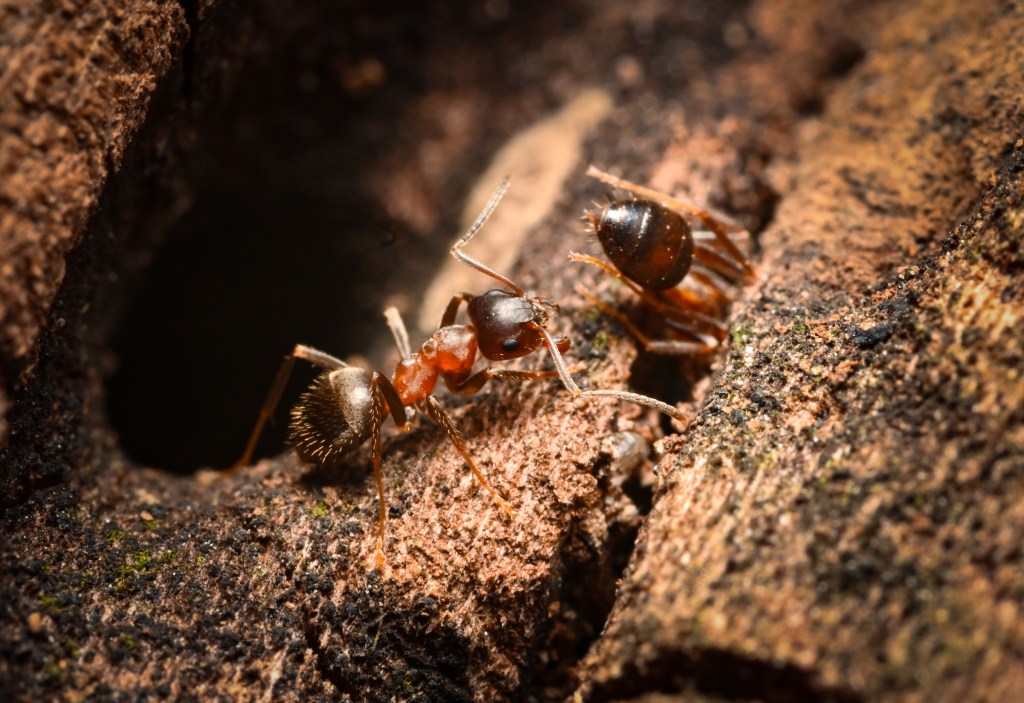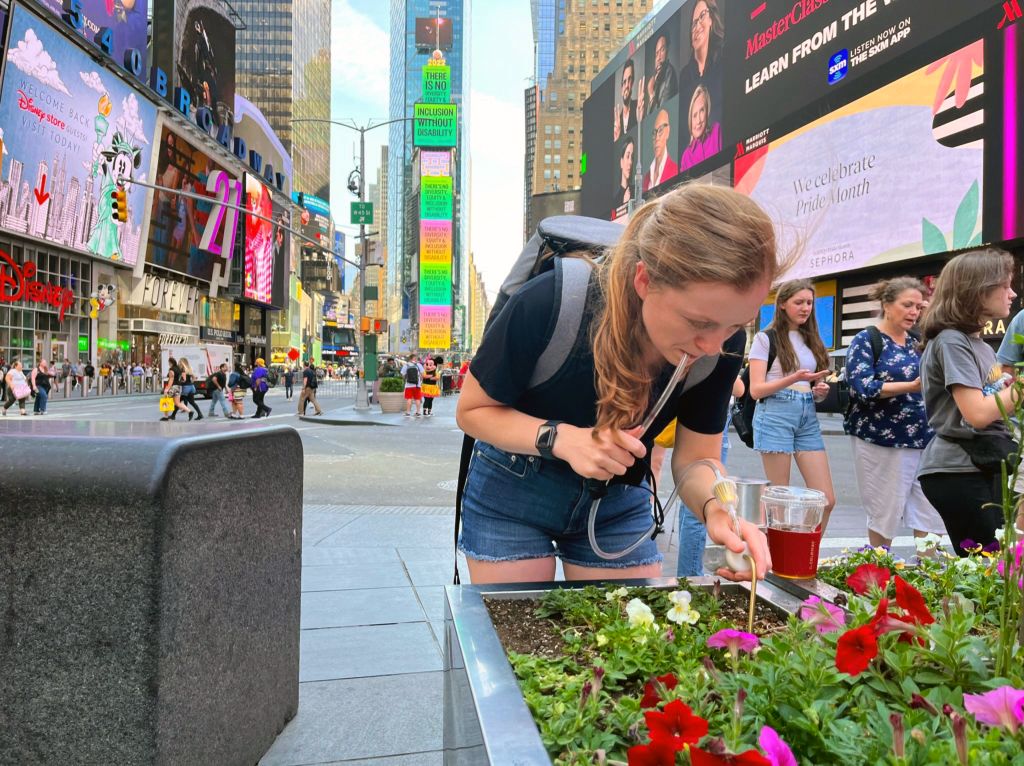Scientists Identify The ‘ManhattAnt’ Spreading Across NYC
10:16 minutes


New York City is home to more than 8 million people. But there’s another massive population below their feet: ants.
In 2011, when surveying ant populations on Broadway and Times Square, researchers got quite a surprise: an unidentified species of ant, which was soon dubbed the “ManhattAnt.” Since then, it has become the second-most populous ant species in New York City.
Earlier this year, the first study on this unidentified species was released. It concluded that this species, Lasius emarginatus, likely hitchhiked from Europe to the US. Though their populations have grown tremendously, it’s unclear how the ants are interacting with New York’s native ants.
Joining guest host Sophie Bushwick to discuss this ant species is Dr. Clint Penick, assistant professor of insect ecology at Auburn University in Auburn, Alabama.

Dr. Clint Penick is an assistant professor of Insect Ecology at Auburn University in Auburn, Alabama.
SOPHIE BUSHWICK: New York City is home to more than 8 million people. But below our feet, there’s another massive population, ants. They’re in our sidewalk cracks, our flowerbeds, even our apartments.
Despite the many ants going about their business in urban areas, they’ve remained pretty understudied. So scientists got a big surprise in 2011 when they discovered a new ant in town and on Broadway, no less. Lovingly dubbed the ManhattAnt, insect ecologists finally know more about this little ant in the big city thanks to my next guest, Dr. Clint Penick, Assistant Professor of Insect Ecology at Auburn University in Alabama. Welcome to Science Friday.
CLINT PENICK: Hi, Sophie. Happy to be here.
SOPHIE BUSHWICK: You’ve recently identified this ant, and it’s not a brand new species. So what do we know about it?
CLINT PENICK: Well, we found out that the ManhattAnt traveled to New York City via Europe. Like several of the other ant species that we have in Manhattan, they’re immigrants, just like many of the immigrants that came to the city through or through multiple waves.
SOPHIE BUSHWICK: And how unusual is it to discover a new type of insect in an urban area like this?
CLINT PENICK: It might not be as unexpected as you would think. We actually have a better handle on a lot of natural spaces that scientists have been working in for many years than we do with our own cities. Our group was actually the first around, you know, over a decade ago to study the biodiversity of ants in New York City. No one in the history of the city had ever thought to do that before. But people have actually looked at natural places and stuff outside the city.
SOPHIE BUSHWICK: And I’ve seen pictures of you collecting data in the city. And I have to ask about your method. It kind of looks like you’re sucking up ants with a straw. So tell me more about that.
CLINT PENICK: Yeah. So we have this special device that we call it an aspirator, which is basically a mouth vacuum. So it has a tube that you put in your mouth and then it’s attached to a vial with a little filter in it, so the ants don’t go in your mouth. And then we point it like a little gun at ants on the sidewalk, and then inhale. And that’s how it works.
SOPHIE BUSHWICK: And what have we learned about New York’s ants from this?
CLINT PENICK: So I originally began working in New York City to understand what ants are eating, how do they survive and thrive in a habitat that basically looks like a concrete jungle. And what I found is that the main ants that we see in the sidewalk, the most common ones survive because we’re sloppy, basically.
[LAUGHTER]
So we drop food, we spill things, and the ants clean it up. They’re basically the unpaid garbage workers of New York City. But the new ant that showed up, the ManhattAnt is different. And so that’s one of the questions that my lab is trying to figure out now, is how they are able to survive on these sidewalks. Because what we do know is that they don’t seem to be eating human foods.
SOPHIE BUSHWICK: Give me an example of some of the human foods they’re eating?
CLINT PENICK: Well, I mean, the classic one we always go to is hot dogs, because it’s New York City. There’s hot dog stands. And we’ve actually done some sort of back of the envelope calculations to figure out how many hot dogs the ants just living on Broadway in new York city eat every year, and it’s 60,000. The ants eat the equivalent of 60,000 hot dogs a year.
[LAUGHTER]
SOPHIE BUSHWICK: That’s wild. But the ManhattAnts aren’t doing this. So how are they establishing themselves?
CLINT PENICK: Yeah, we don’t exactly know yet what the ManhattAnts are doing to survive. But what we seem to think that they’re doing is that when we see them foraging, they’re climbing up trees that are planted along the sidewalk. And so whatever they’re eating is in the canopy of these trees.
And so there’s bugs and other insects that are up there. And some of them produce this substance, the sugary substance that’s called honeydew. And so these are insects that feed on plant fluids. And then, basically, their poop is sugar. And that’s what the ants, we think, are eating.
SOPHIE BUSHWICK: So the insects that do that, this is reminding me of another invasive species, the spotted lanternfly. Is that something that produces honeydew?
CLINT PENICK: Yes, exactly. So New Yorkers now are pretty familiar with the sight of these pink and purple lanternflies, which are really beautiful but are really troubling and invasive. And so lanternflies, yeah, they do. They feed on plant tissues and they produce honeydew.
And we’ve actually seen ManhattAnts interacting with them. So now we have this sort of mix of species from all over the world that are coming together. And I guess, you know, much like humans are sharing their culinary culture and exchanging foods, hopefully it turns out good for the human residents in New York. But yeah, they definitely interact with lanternflies.
SOPHIE BUSHWICK: Yeah, I’m kind of curious about what you think the result would be of this kind of interaction.
CLINT PENICK: This is something that ants have evolved to do in a number of different contexts. But when they feed on honeydew produced by something like lanternflies, the ants obviously are getting food from this mutualism. What they give back to the insects is protection.
So ants can basically serve as the bouncers and bodyguards for honeydew producing insects like lanternflies. So if this continues, and especially if the ManhattAnt spreads out of New York City, as it’s already starting to do, and makes it into agricultural areas where lanternflies are more of a pest, it’s possible that these ants could be protecting lanternflies and helping them develop larger populations.
SOPHIE BUSHWICK: So that’s not good. We’re supposed to be stomping on lanternflies, not helping them. So I mean, is there anything we can do to prevent ManhattAnts from doing that?
CLINT PENICK: Well, right now we’re just trying to keep an eye on them. When we discovered them, they were pretty rare. We found them in a couple kind of deep forested areas of parks in New York City, kind of tucked in dark parts of Central Park.
But what we found is that they’re actually thriving. They’re able to move into the most urban areas of the city. And so we really don’t know how their populations are going to impact native species or other invasive species like lanternflies. So over time, we’ve realized that they’ve become more prominent than we would have guessed at the beginning.
And my lab is focused on tracking their populations and trying to tease apart what their effects could be. And one way people could help is that we actually created a project through iNaturalist called Project ManhattAnt. And on that site, you can take pictures of ants that you think are ManhattAnts and upload them. And then that helps us track their populations and see where they are.
SOPHIE BUSHWICK: What do they look like, for people who are going on a hunt for this kind of ant?
CLINT PENICK: Yeah, to me, I always tell people that they’re kind of big, but they’re not really that big. So to an ant person, they’re bigger than a lot of ants, but they’re kind of a medium sized ant. But the characteristic that can that can help someone ID them is that they’re red and black.
And they’re the only ant of that size in New York City, and really through much of the Northeast that you’ll commonly see that’s red and black. They have a black head and a black abdomen and then their thorax is red.
SOPHIE BUSHWICK: And you’ve also mentioned the native species of ant that was found in Manhattan before these ants moved in. So what is the most common ant in the city?
CLINT PENICK: Yeah, so Manhattan is quite diverse. There’s a lot of ant species there. We’ve actually documented over 40 different species of ants just in Manhattan alone, which is more than has been found in the nearest protected area outside the city. So by all measures, New York City is quite diverse when it comes to ants.
The most common ant in New York is, like the ManhattAnt, is not native. It’s called the pavement ant. They’re also from Europe, but they’ve been there much, much longer. So the pavement ants probably came to New York City in some of the early waves of immigrants.
They’ve at least been there 100 years, potentially longer. But they’ve kind of been adopted as naturalized residents, like many New Yorkers, like many different people who come to new York. They live mostly on the sidewalks. They’re not a huge pest. They don’t get in people’s homes. But they’re the ones up until the last 10 years or so that have dominated the sidewalks of New York City.
SOPHIE BUSHWICK: And how are these species interacting? Do they seem to get along OK?
CLINT PENICK: We don’t know that yet. But we do know is that when they do meet each other, they sometimes fight. So we’ve seen the ManhattAnt tearing apart some pavement ants, and probably the opposite happens as well. So right now, it could just be, you know, a battle for the for the streets to see which ant comes on top.
SOPHIE BUSHWICK: And learning about this overlooked activity is making me think of a great line from your paper about these ants. You wrote, “often the only visual non-humans in Times Square are humans dressed as Disney animals. And yet hidden in this flower pot was a whole society of animal beings.”
CLINT PENICK: Yeah, so this is something that really surprised me. As someone, I mean, I’ve been working in New York City on ants for the better part of a decade. And where we work tends to be in the Upper West Side or in some of the park habitats.
But I went with my student, Samantha Kennett, and we decided to look in the most dense, the most urban part of the city, which is Times Square. And sure enough, all we had to do was peek inside a flower pot and we found a full colony of the ManhattAnt thriving, you know, in the midst of thousands of people who are probably there already.
And yeah, and like what we wrote in the paper as sort of a tongue in cheek joke. But there’s all these characters dressed up as animals in Times Square. But the only animal besides us humans were the ManhattAnts, and they seem to be doing quite well.
SOPHIE BUSHWICK: And I wanted to get back to the citizen science aspect of this. We know that we want to stop invasive species, so that involves stomping on lanternflies. We know that we want to learn more about the ManhattAnt, and you’ve got that project on iNaturalist. Do you have any other advice for folks who might want to get involved in ant hunting?
CLINT PENICK: Yeah, I mean, ants are one of the easiest things to find. I mean, whether you want to find them or not, they end up in your kitchen. They end up on our sidewalks. And so, yeah, I do ask people, just pay attention. There’s a lot of species.
We have something like 800 species of ants that are native to the United States. And like I said, 40 of them are in our biggest and densest city. So if you can get out there and take some photos of them and upload them to iNaturalist, we would certainly appreciate it.
SOPHIE BUSHWICK: That’s all the time we have. For now, I’d like to thank my guest, Dr. Clint Penick, Assistant Professor of Insect Ecology at Auburn University in Alabama. Thank you for joining us.
CLINT PENICK: Yeah, thank you.
Copyright © 2024 Science Friday Initiative. All rights reserved. Science Friday transcripts are produced on a tight deadline by 3Play Media. Fidelity to the original aired/published audio or video file might vary, and text might be updated or amended in the future. For the authoritative record of Science Friday’s programming, please visit the original aired/published recording. For terms of use and more information, visit our policies pages at http://www.sciencefriday.com/about/policies/
Kathleen Davis is a producer and fill-in host at Science Friday, which means she spends her weeks researching, writing, editing, and sometimes talking into a microphone. She’s always eager to talk about freshwater lakes and Coney Island diners.
Sophie Bushwick is senior news editor at New Scientist in New York, New York. Previously, she was a senior editor at Popular Science and technology editor at Scientific American.